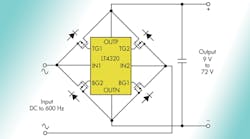Controller Lets Designers Replace Rectifier Bridge Diodes With MOSFETs
With Linear Technology’s LT4320 ideal-diode bridge controller, power supply designers can replace each of the four diodes in a conventional full-wave bridge rectifier with a low-loss N-channel MOSFET. (For any given rating, N-channel devices are physically smaller and cheaper than P-channel devices.) The output voltage range is 9 to 72 V with an 80-V absolute maximum. Power output depends on the MOSFET ratings. It may range from one to hundreds of watts
This file type includes high resolution graphics and schematics.
In operation, the LT4320 reads the incoming ac voltage waveform and smoothly turns on the appropriate pair of MOSFETs for each half cycle (see the figure).
Replacing the silicon rectifier diodes in a full-wave bridge with N-type MOSFETs eliminates the Vf drop in each conducting pair. The effects of the gain in efficiency are not trivial. To accomplish this, Linear Technology has introduced the first controller IC that handles the task of syncing the MOSFETs to the power line. To provide gate drive for the MOSFETs, it integrates a charge pump, including capacitors.
Replacing conventional bridge rectifier diodes with MOSFETs eliminates the silicon diode’s inescapable 0.6-V forward voltage drop (Vf) and associated thermal effects. For a MOSFET, Vds(on) losses can be much lower. Linear says the typical advantage is a reduction in losses by a factor of 10.
The company points out some less obvious advantages of the design. For example, in Power over Ethernet (PoE) applications, the 9-V low end of the operating range allows the use of 12-V wall adapters as the power source. Further, the dc to 600-Hz input line-voltage spec covers 50- and 60-Hz worldwide standards and 400-Hz aircraft ac buses. Higher frequencies are possible depending on MOSFET size.
Operating temperatures range from –40°C to 85°C. Packaging options comprise an eight-pin, 3- by 3-mm dual flat no-lead (DFN) package and a 12-lead mini small-outline package (MSOP) with enhanced high-voltage pin spacing. Pricing starts at $2.95.
This file type includes high resolution graphics and schematics.

